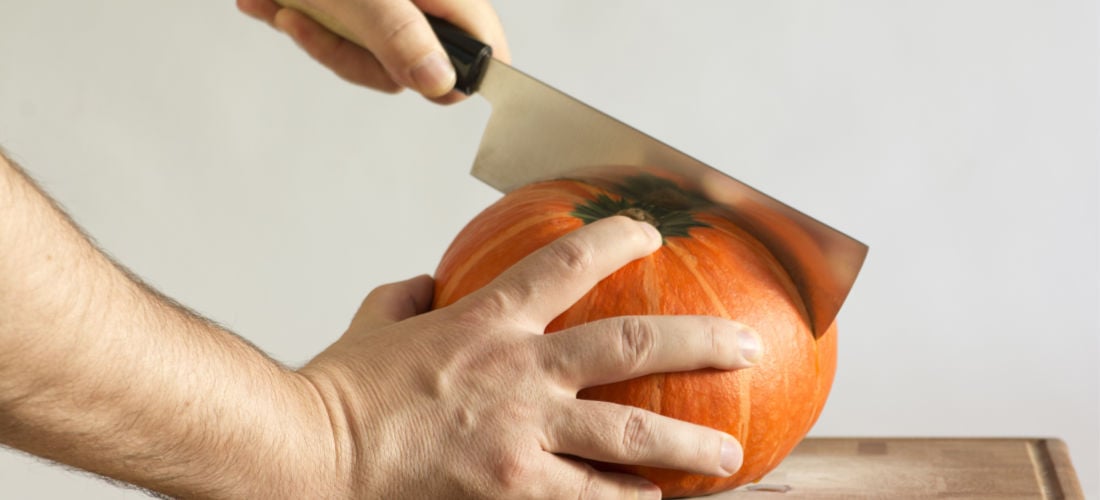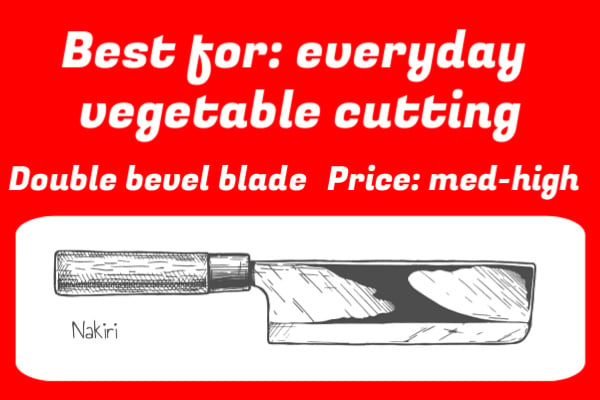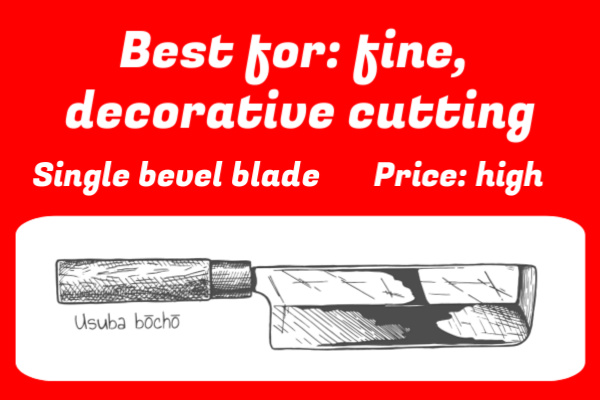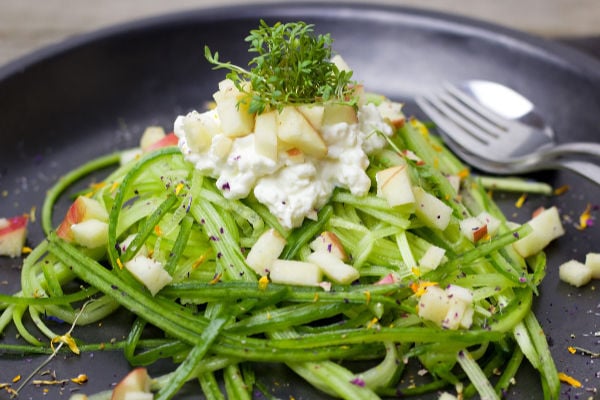The main difference between Usuba and Nakiri knives is their blade type; Usuba is single-beveled, thin, and sturdy, while Nakiri is double-beveled and delicate. Nakiri is beginner-friendly, while Usuba needs expert blade-sharpening skills.

Although Usuba and Nakiri look almost similar, you can also tell their weight difference right off the bat: Usuba is heavier, while Nakiri is lighter. When it comes to price, Usuba is more expensive than Nakiri.
More differences between Usuba and Nakiri result in their different uses in the kitchen, and you will learn them in this article. Read on to discover their strengths and weaknesses to help you choose the best knife for your needs.
Table of Contents
Usuba and Nakiri Compared
| Usuba | Nakiri | |
|---|---|---|
| Best use | Fine or decorative cutting | All round vegetable processor |
| Weight | Heavier | Lighter |
| Blade sharpening skill | Expert | Beginner |
| Right or Left handed? | Either right or left handed | One knife can be used by both |
| Blade | Single bevel, thin but sturdy. | Double bevel, very delicate. |
| Price | High Range | Mid-High Range |
If you need to cut vegetables (and let's face it, we all do), you'd be hard-pressed to beat a usuba or nakiri. With their sleek-looking design, either will make an impressive showpiece for your kitchen.
But let's not forget their biggest strength: cutting through any vegetable with ease and extreme precision. Julienne, brunoise, fine dicing, and rotary peeling are made easier with one of these knives. Katsuramuki, a fundamental Japanese cutting technique that involves slicing paper-thin sheets of vegetables such as daikon, would be impossible without one of these knives. Try it with that regular knife of yours if you don't believe me.
The Benefits Both These Knives Share
- Length: the blade is long enough to deal with most vegetables.
- Extreme sharpness: Slice through delicate vegetables without damaging them.
- Straight edged blade: Resulting in even cuts that look perfect.
- Clean cuts: no more pieces of vegetable stuck together by threads (think celery!).
- Easy to cut: no need to rock the blade, simply push down in one motion.
- Precision: Make perfect, thin slices that bring a dish to life.
If they're both such good knives, does it even matter which one you choose? Absolutely. Let's look at each knife in more detail.
Nakiri
A nakiri is designed to be simple but it is very effective at cutting and is also highly versatile. Loosely translated, "na" means leaf, and "kiri" means cutting tool. In other words, this is your go-to blade for prepping vegetables and slicing them thinly if necessary.

The blade edge is very flat and also very tall. You can cut without needing to use a rocking motion, and your knuckles won't make contact with the chopping board thanks to its height.
The nakiri is an ideal tool for beginner-to-intermediate level cooks. Thanks to its double-beveled blade, it is easier to cut with, and sharpening is a simple job.
Usuba
The usuba offers extraordinary cutting performance thanks to its remarkably sharp blade. Don't use this beast after a few drinks!
Like the nakiri, it is designed for cutting vegetables, and what a job it does!

Usuba is the Japanese word for "thin blade." It gets this name because it is a single-bevel knife. That means it is only sharpened on one side. When cutting straight down, you'll notice that these knives tend to cut a little to the left if you have a right-handed usuba. The opposite applies to the left-handed version. This design will take some practice to get used to.
The Usuba is the ideal tool for precision cutting. Need to cut wafer-thin daikon radish? This knife is the tool for the job.
Quick Fact: In Japan's Kanto region, the usuba has a square tip; in the Kansai region, the knife has a rounded tip.
Check out this Usuba in action
Which is the Best Option?
Do you need an all-rounder?
If you're looking for a knife that'll chop its way through all those everyday vegetables, then the nakiri is the knife for you. It's designed to make your casserole, soup, and salad preparation easy.
Need a high-end blade for decorative work?
The usuba is what you need. Its single-edged, thin blade is what Japanese chefs use for decorative vegetable preparation. If it's good for them, it'll work for you too. Just keep in mind, it's not easy.
How are your blade-sharpening skills?
I won't lie to you. Sharpening the usuba is difficult. It takes a particular skill, which many will find an insurmountable challenge. Keep this in mind because there will be an additional ongoing cost to get your knife sharpened.
Do you care about the knife's weight?
The usuba has a thicker blade, so if you compared the two knives of similar length, the nakiri would weigh less. The weight difference can be considerable.

Infographic: Which Knife Measures Up?

Final Words
The usuba and nakiri share a similar blade profile, and they're both designed primarily for slicing vegetables. The fact that this blade has no belly means that precise, controlled chopping is achievable.
Professional chefs in Japan more commonly use the usuba. It's one of the main knives used along with the yanagiba and deba. When a trainee chef starts training, the first knife they'll learn to master will be the usuba. That's because it's used for vegetables. If the trainee makes a mess of their cutting, it won't hit the bottom line of the restaurant so hard as what it would if they wasted fish.
Getting used to an usuba will take a lot of time, patience, and practice. If you need to cut vegetables with precision and you're willing to put in the time, then this is the knife for you. Treat it with respect and keep it sharpened, and it'll serve you for many years.
The nakiri knife will likely be better suited for most readers on this page. Anyone that's looking for a premium quality knife to cut everyday vegetables with ease should go for a nakiri. It's easier to operate and sharpen, lighter, and will probably save you some money.
The one final consideration is aesthetics. The usuba may not be the best knife for everyday use at home, but it sure is the best looking option. It's a work of art, and its single beveled blade makes it a showpiece for the kitchen. Pull that impressive looking tool out when you have guests and they're sure to admire it enviously. A usuba isn't a necessity, but for those that can afford it, why not spoil yourself? You work hard in that kitchen and deserve something nice, right?

Leave a Reply